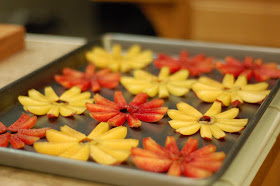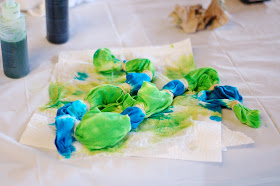I am not one to pass up an opportunity to learn new techniques for fun crafts. A month (or so) ago, I was invited to attend a
tie-dye class put on by the
iLoveToCreate team! I just supplied my own item to dye and used a
Tye-dye kit that I had received as part of a give away.
We all layed our kits and items to die out on the table. Here are a few pointers...
A kit is a great way to get most of the supplies you will need: Bottles of powder dye (just add water), Gloves, Rubber Bands, Idea sheet and instructions
A tie-dye kit will make multiple items, there are a variety of items you could create: T-shirts, tanks, dresses, pants, skirts, shorts, swim cover or towels, etc.!
You should plan on having a few extra supplies on hand: Gallon sized plastic bags (Ziploc style); cover or tablecloth to cover your work surface; Apron; Water to dampen items before dyeing
There are a few different techniques we learned about. Here is what I will call the "scrunching" method. (I have no idea what it is really supposed to be called.) Literally, just lay the shirt flat, then SCRUNCH it into a wrinkly little ball by pinching it together in various areas.
Then just squeeze on the dye.
This is more of a "traditional" dyeing technique. Squeeze the shirt into a long snake, tie a number of rubber bands around it tightly.
Use the bottles of dye and squeeze liberally onto the untied portion of the shirt.
Whenever an item is done, place it in a plastic bag. The dye needs to soak for a whole day before being rinsed.
Here is one of the finished, rinsed, and washed shirts I made using a basic tie dye method. I think it came out cute, although next time I will soak it with a little more dye and maybe let it set for 48 hours to make sure the colors stay a little more vibrant.
This is called "Shibori"
You take the item to be dyed and lay it onto a large cardboard tube. Roll the fabric up, around the tube.
Once the item is all rolled around the tube, scrunch the fabric together pushing from the outside in.
For this technique, you need to add your dye to a spray bottle. Spray the dye onto the scrunched fabric.
You will have to gently unroll the item and make sure the sprayed dye is soaking into the fabric. You may have to take the item off the tube and roll it again on the other side.
Pretty cool effect, huh?!!?
These are the great little bottles that come with the tie-dye kits. Save these! You might be able to use them for your next tie-dye project!!!

















































